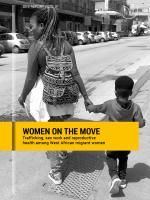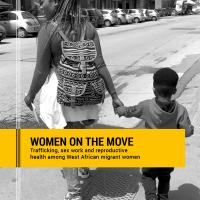Debt is the invisible cause of women's migration
Pictures of drowning inflatable boats full of desperate migrant mothers and their children crossing the Mediterranean Sea and dramatic stories of trafficked women, sexually exploited have been in the spotlight for years. West African women working in the European sex industry are not invisible in the public debate, yet many aspects of this migration remain deliberately hidden or forgotten and therefore invisible. Their presence is made visible, but to what extent are they actually seen?
The roots, the means and the ends of their migratory experience remain invisible. The reasons behind migrant women’s choices to leave West Africa, their role in the smuggling experience, their life after being rejected, arrested, or deported, are left in the shadows.
The new DIIS Report ‘Women on the move´ seeks to shed light on often hidden aspects, such as private debt that forces women to undertake dangerous journeys, and to nuance the picture of migrant women seen as either criminals or victims.
West African migrant women working in the European sex industry are seen and portrayed - through whose lenses and by whom? - in the public debate and political discourse either as victims of trafficking, worthy of assistance or as criminals who violated European migratory laws, worthy of a one-way ticket home.
All the nuances in between these two extremes and the stories of women who don’t fall in these two categories are made invisible. Visibilization and invisibilization work on specific aspects of their migratory experience.
Private debt and debt to the state
One of these aspects is private debt. Although private debt is a powerful motive for migration, it is almost completely invisible in the migration debate, it doesn’t attract the spotlight. Migration and migrant sex work very often are long-distance debt restructuring, as selling sex in Europe is a strategy for migrant women to interrupt the vicious circle of debt which traps their families.
The migratory journey is often only possible by further exacerbating private debt of migrant women with sponsors, madams, or smugglers. But debt is not only owed to private and illicit facilitators, but it can also accumulate during transit at the hands of the state. In Tunisia for example, migrant women must pay a daily fine if they overstay the first three months upon their arrival. This forces them to accept any kind of working conditions as they end up having yet another creditor, the state.
Obscuring debt as the reason behind the migratory decision, thereby invisibilizing the structural problem of private debt in the Global South, makes our understanding of the phenomenon narrow and our approach to it inevitably inappropriate.
Treating the symptoms of the problem through intercepting smugglers at European borders, implementing local anti-trafficking awareness campaigns and criminalizing the purchase of sex, does not solve the problem at its roots.
Sex work is a way to pay back debt
Another aspect often invisibilized is how women on the move think about themselves. Many of the women interviewed in this project identified themselves as labour migrants. Selling sex in Europe is a way of earning money to pay back debts with smugglers and previous debts. Our understanding of trafficking should consider the active role in the migratory decision played and claimed by many migrant women.
Making invisible what women identify themselves with and how they want to be represented reinforces the narrative of women as “just victims”. Research on the contrary has shown that they often navigate a complex set of strategies between coercion and voluntariness.
Therefore, this report draws on the concept of trafficking-migration continuum, which asserts the idea that the point at which tolerable forms of sex work related migration ends, and human trafficking begins, will vary according to political, individual, and moral values and experiences not easily captured by legal definitions. By considering that, light is shed on the many stories that too often remain in the shadows.
Visibilization and invisibilization are relative and depend on power relations. Making the whole picture more visible questions the oversimplified human trafficking narrative and European countries’ attempt to hinder migration with preventive campaigns.
A new focus on the structural problem of debt could facilitate the implementation of new economic infrastructures by governments, as well as looking at migrant women as labour migrants and sex workers could guide the implementation of new sex work policies and reform existing ones. Invisibility is not about not being seen at all, but about to what extent the whole picture is made visible
DIIS Experts





